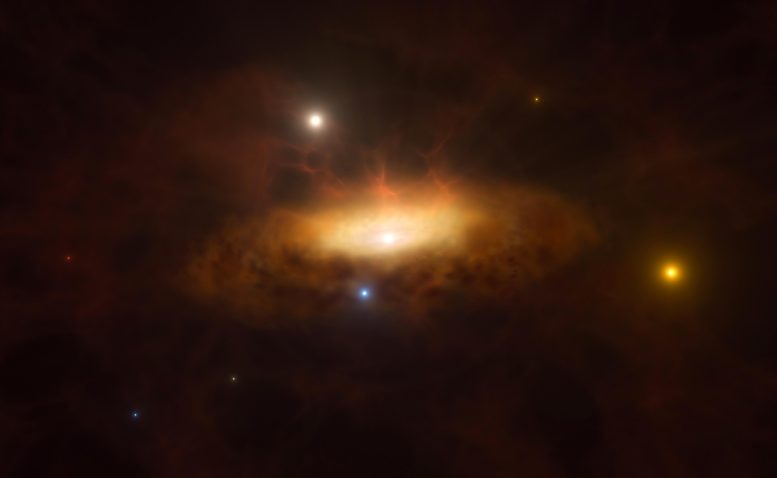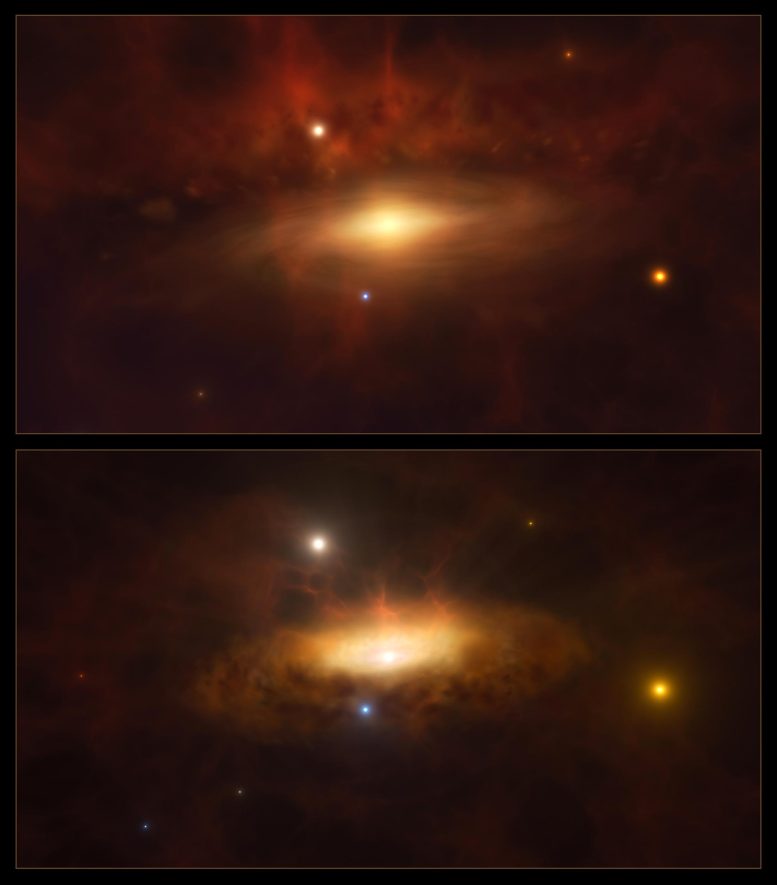Witnessing a Massive Black Hole’s Dramatic Awakening


In late 2019, a previously unremarkable galaxy suddenly started shining brighter, suggesting the sudden awakening of a massive black hole at its core. Astronomers using data from multiple observatories noticed dramatic changes in brightness that hint at unprecedented astronomical phenomena, further highlighted by new X-ray emissions detected in early 2024. (Artist’s concept.) Credit: SciTechDaily.com
Astronomers believe the 2019 brightening of galaxy SDSS1335+0728 may be the first real-time observation of a massive black hole awakening.
The galaxy’s persistent increase in light across various wavelengths and the onset of X-ray emissions make this event unprecedented.

In late 2019, the galaxy SDSS1335+0728 suddenly started shining brighter than ever before and was classified as having an active galactic nucleus, powered by a massive black hole in the galaxy’s core. This is the first time the awakening of a massive black hole has been observed in real-time. This artist’s impression shows the growing disc of material being pulled in by the black hole as it feeds on the gas available in its surroundings, making the galaxy light up. Credit: ESO/M. Kornmesser
Unprecedented Brightening
Suddenly, in late 2019, the previously unremarkable galaxy SDSS1335+0728 started shining brighter than ever before. To understand why, astronomers used data from several space and ground-based observatories, including the European Southern Observatory’s Very Large Telescope (ESO’s VLT), to track how the galaxy’s brightness has varied.
In a study published in Astronomy & Astrophysics today (June 18), they conclude that they are witnessing changes never seen before in a galaxy — likely the result of the sudden awakening of the massive black hole at its core.
This animation shows the growing disc of material around the massive black hole at the center of the galaxy SDSS1335+0728. In late 2019 this galaxy suddenly started shining brighter than ever before and was classified as having an active galactic nucleus, powered by the central black hole feeding off the surrounding material. Credit: ESO/M. Kornmesser
Awakening of a Black Hole
“Imagine you’ve been observing a distant galaxy for years, and it always seemed calm and inactive,” says Paula Sánchez Sáez, an astronomer at ESO in Germany and lead author of the study accepted for publication in Astronomy & Astrophysics. “Suddenly, its [core] starts showing dramatic changes in brightness, unlike any typical events we’ve seen before.” This is what happened to SDSS1335+0728, which is now classified as having an ‘active galactic nucleus’ (AGN) — a bright compact region powered by a massive black hole — after it brightened dramatically in December 2019.[1]

This artist’s impression shows two stages in the formation of a disc of gas and dust around the massive black hole at the center of the galaxy SDSS1335+0728. The core of this galaxy lit up in 2019 and keeps brightening today — the first time we observe a massive black hole become active in real-time. Credit: ESO/M. Kornmesser
Persistent Brightness: An Ongoing Mystery
Some phenomena, like supernova explosions or tidal disruption events — when a star gets too close to a black hole and is torn apart — can make galaxies suddenly light up. But these brightness variations typically last only a few dozen or, at most, a few hundred days. SDSS1335+0728 is still growing brighter today, more than four years after it was first seen to ‘switch on’. Moreover, the variations detected in the galaxy, which is located 300 million light-years away in the constellation Virgo, are unlike any seen before, pointing astronomers towards a different explanation.
New Observations and Theories
The team tried to understand these brightness variations using a combination of archival data and new observations from several facilities, including the X-shooter instrument on ESO’s VLT in Chile’s Atacama Desert.[2] Comparing the data taken before and after December 2019, they found that SDSS1335+0728 is now radiating much more light at ultraviolet, optical, and infrared wavelengths. The galaxy also started emitting X-rays in February 2024. “This behavior is unprecedented,” says Sánchez Sáez, who is also affiliated with the Millennium Institute of Astrophysics (MAS) in Chile.
“The most tangible option to explain this phenomenon is that we are seeing how the [core] of the galaxy is beginning to show (…) activity,” says co-author Lorena Hernández García, from MAS and the University of Valparaíso in Chile. “If so, this would be the first time that we see the activation of a massive black hole in real-time.”
Historical Observation of Galactic Phenomena
Massive black holes — with masses over one hundred thousand times that of our Sun — exist at the center of most galaxies, including the Milky Way. “These giant monsters usually are sleeping and not directly visible,” explains co-author Claudio Ricci, from the Diego Portales University, also in Chile. “In the case of SDSS1335+0728, we were able to observe the awakening of the massive black hole, [which] suddenly started to feast on gas available in its surroundings, becoming very bright.”
This video zooms into the galaxy SDSS1335+0728, which in late 2019 suddenly started shining brighter than ever before and was classified as having an active galactic nucleus. An inset at the end of the video shows an artist’s animation of the massive black hole at the center of the galaxy, with the growing disc of material being pulled in by the black hole as it feeds on the gas available in its surroundings. This is the first time the awakening of a massive black hole has been observed in real-time.
Implications for Future Astronomical Observations
“[This] process (…) has never been observed before,” Hernández García says. Previous studies reported inactive galaxies becoming active after several years, but this is the first time the process itself — the awakening of the black hole — has been observed in real-time. Ricci, who is also affiliated with the Kavli Institute for Astronomy and Astrophysics at Peking University, China, adds: “This is something that could happen also to our own Sgr A*, the massive black hole (…) located at the center of our galaxy,” but it is unclear how likely this is to happen.
Continuous Monitoring and Future Prospects
Follow-up observations are still needed to rule out alternative explanations. Another possibility is that we are seeing an unusually slow tidal disruption event, or even a new phenomenon. If it is in fact a tidal disruption event, this would be the longest and faintest such event ever observed. “Regardless of the nature of the variations, [this galaxy] provides valuable information on how black holes grow and evolve,” Sánchez Sáez says. “We expect that instruments like [MUSE on the VLT or those on the upcoming Extremely Large Telescope (ELT)] will be key in understanding [why the galaxy is brightening].”
Notes
- The SDSS1335+0728 galaxy’s unusual brightness variations were detected by the Zwicky Transient Facility (ZTF) telescope in the US. Following that, the Chilean-led Automatic Learning for the Rapid Classification of Events (ALeRCE) broker classified SDSS1335+0728 as an active galactic nucleus.
- The team collected archival data from NASA’s Wide-field Infrared Survey Explorer (WISE) and Galaxy Evolution Explorer (GALEX), the Two Micron All Sky Survey (2MASS), the Sloan Digital Sky Survey (SDSS), and the eROSITA instrument on IKI and DLR’s Spektr-RG space observatory. Besides ESO’s VLT, the follow-up observations were conducted with the Southern Astrophysical Research Telescope (SOAR), the W. M. Keck Observatory, and NASA’s Neil Gehrels Swift Observatory and Chandra X-ray Observatory.
Reference: “SDSS1335+0728: The awakening of a ~10^6 M_sun black hole” by P. S’anchez-‘aez, L. Hernandez-Garcia, S. Bernal, A. Bayo, G. Calistro Rivera, F.E. Bauer, C. Ricci, A. Merloni, M.J. Graham, R. Cartier, P. Arevalo, R.J. Assef, A. Concas, D. Homan, M. Krumpe, P. Lira, A. Malyali, M.L. Martínez-Aldama, A.M. Munoz Arancibia, A. Rau, G. Bruni, F. Forster, M. Pavez-Herrera, D. Tubin-Arenas and M. Brightman, 18 June 2024, Astronomy & Astrophysics.
DOI: 10.1051/0004-6361/202347957
The team is composed of P. Sánchez-Sáez (European Southern Observatory, Garching, Germany [ESO] and Millenium Institute of Astrophysics, Chile [MAS]), L. Hernández-García (MAS and Instituto de Física y Astronomía, Universidad de Valparaíso, Chile [IFA-UV]), S. Bernal (IFA-UV and Millennium Nucleus on Transversal Research and Technology to Explore Supermassive Black Holes, Chile [TITANS]), A. Bayo (ESO), G. Calistro Rivera (ESO and German Space Agency [DLR]), F. E. Bauer (Instituto de Astrofísica, Pontificia Universidad Católica de Chile, Chile; Centro de Astroingeniería, Pontificia Universidad Católica de Chile, Chile; MAS; and Space Science Institute, USA), C. Ricci (Instituto de Estudios Astrofísicos, Universidad Diego Portales, Chile [UDP] and Kavli Institute for Astronomy and Astrophysics, China), A. Merloni (Max-Planck-Institut für Extraterrestrische Physik, Germany [MPE]), M. J. Graham (California Institute of Technology, USA), R. Cartier (Gemini Observatory, NSF National Optical-Infrared Astronomy Research Laboratory, Chile, and UDP), P. Arévalo (IFA-UV and TITANS), R.J. Assel (UDP), A. Concas (ESO and INAF – Osservatorio Astrofisico di Arcetri, Italy), D. Homan (Leibniz-Institut für Astrophysik Potsdam, Germany [AIP]), M. Krumpe (AIP), P. Lira (Departamento de Astronomía, Universidad de Chile, Chile [UChile], and TITANS), A. Malyali (MPE), M. L. Martínez-Aldama (Astronomy Department, Universidad de Concepción, Chile), A. M. Muñoz Arancibia (MAS and Center for Mathematical Modeling, University of Chile, Chile [CMM-UChile]), A. Rau (MPE), G. Bruni (INAF – Institute for Space Astrophysics and Planetology, Italy), F. Förster (Data and Artificial Intelligence Initiative, University of Chile, Chile; MAS; CMM-UChile; and UChile), M. Pavez-Herrera (MAS), D. Tubín-Arenas (AIP), and M. Brightman (Cahill Center for Astrophysics, California Institute of Technology, USA).

